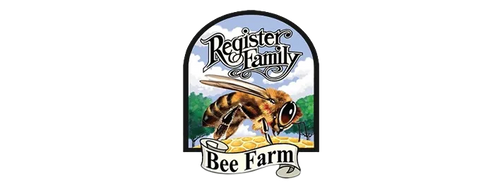As the honey season progresses, the bees continue to target the ever-changing nectar and pollen sources as some plants are done blooming and others are just beginning. This time of year, Register Family Farm is working largely in the agricultural areas of northwest Florida making cotton honey. Most nectar-producing plants in our area only bloom for two to three weeks. The cotton honey flow, though a low volume producer comparatively, can last for more than a month. This allows for a nice change of pace as we are coming off of the popcorn flow and the hectic cycle of; move, super, pull, extract, move of the last few months.
Hive Maintenance and Splits
In the beekeeping business, a split refers to separating the bees into two or more groups with each group having the necessary resources to form its own colony. We are busy making more colonies this time of year to recover the natural and inevitable loss of colonies that happens throughout the honey season. We take a stronger hive and pull some food and "brood" frames out and place them in a separate box. Food frames contain honey and pollen, and brood refers to honey bee eggs and larvae. The new hive is moved to a new location at least two miles away from the parent colony and given a new queen. We then feed the young hive nutritional supplementation, such as sugar syrup and pollen substitute to augment what the low population of the hive can bring in on their own. Feeding the young hives gives them the boost they need to build up quickly and be self-sufficient.
Popcorn and the Bees
Popcorn honey production is all wrapped up, but it is an interesting tree and an important topic to highlight. The Chinese tallow (nicknamed the popcorn tree) is in full bloom by June, which begins what is perhaps the hardest time of the year for bee farming, considering how hot and humid summer is in this area. Popcorn trees are densely populated and provide a fantastic source of nectar and pollen. It is also the last dependably good nectar and pollen source for bees in this area and can account for as much as twenty percent of the total volume of honey produced in a given year.
The popcorn tree is originally from eastern Asia, and it is considered an invasive species. Due to the these trees virtually taking over sections of the wetlands, a lot of communities are trying to eradicate them. In our opinion, the good outweighs the bad when it comes to Chinese tallow. According to Bee Culture, Chinese tallow nectar is “non-toxic, and it has become a major honey plant for beekeepers. The honey is of high quality, and is produced copiously during the month of June, on the Gulf Coast. In the Gulf coast states, beekeepers migrate with their honey bees to good tallow locations near the sea.”
We can tell you firsthand that they are good for the bee population and do a great job at keeping the bees healthy going into the summer, which is a pretty big benefit, considering the Science Daily reported that the U.S. lost over 40 percent of bee colonies last year.
The Benefit of Honey Bees as Pollinators
The U.S. Fish and Wildlife Service states, “Pollinators, such as most bees and some birds, bats, and other insects, play a crucial role in flowering plant reproduction and in the production of most fruits and vegetables.
Examples of crops that are pollinated include apples, squash, and almonds. Without the assistance of pollinators, most plants cannot produce fruits and seeds. The fruits and seeds of flowering plants are an important food source for people and wildlife. Some of the seeds that are not eaten will eventually produce new plants, helping to maintain the plant population. It plays a vital role in honey production and maintaining the environment.”
Wikipedia describes pollination like this: “Honey bees travel from flower to flower, collecting nectar (later converted to honey), and pollen grains. The bee collects pollen by rubbing against the anthers. The pollen collects on the hind legs, in a structure referred to as a "pollen basket.” As the bee flies from flower to flower, some of the pollen grains are transferred onto the stigma of other flowers. Good pollination keeps the flowering plants in the area healthy and productive, and it promotes new growth too.
The Cotton Cooldown
As we mentioned before, making cotton honey is a longer process, so it allows us to slow down a little bit and gives us a chance to catch up on other farm operations such as repairing damaged boxes and pallets as well as vehicle maintenance. We're also trying to build more storage space for keeping our various equipment safe and out of the weather. Thoroughly cleaning and preparing for the next extraction is also on the list.
Following months of hectic honey production, our family is enjoying this little break to regroup and prepare as we continue our pursuit of producing the best honey possible for our customers. As always, if it has a Register Family Farm label, you can be sure that it is the highest quality honey Northwest Florida has to offer.
